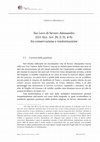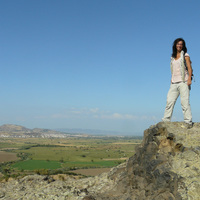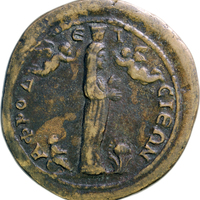Books by Cristian Mondello

Tokens in Classical Athens and Beyond, 2023
The present volume does not stand in isolation. Rather, it should be seen against the backdrop of... more The present volume does not stand in isolation. Rather, it should be seen against the backdrop of two recent volumes, both dedicated to tokens: Tokens: Culture, Connections, Communities, Royal Numismatic Society Special Publication 57 (London: Royal Numismatic Society, 2019) and Tokens, Value and Identity: Exploring Monetiform Objects in Antiquity and the Middle Ages (Brussels: Centre d’études numismatiques, 2021). In its own right, the volume has a lot to recommend it. It fits neatly into a gap of modern scholarship: no systematic discussion of the material has previously been undertaken, although tokens have been found by the hundreds in Athens and are catalogued in nineteenth-century publications (see below). Athenian tokens were signalled as a special category in Numismatics from an early date, and they were arranged in carefully considered categories: the small bronze tokens with diameters not larger than 8 mm and with designs or letters on both faces or a letter on one and a design on the other, the bronzejurors’ tokens with letters on at least one face, the lead tokens with their remarkable variety of types, the clay ‘military’ tokens inscribed with names, as well as the clay coin-shaped specimens. This categorisation was the result of successive publications by eminent scholars through the decades: Achilles Postolakas (1880 and 1884) on the small bronze tokens, Achilles Postolakas [Postolacca] (1866 and 1868), Arthur Engel (1884), J.N. Svoronos (1900) and Margaret Crosby (1964) on the lead ones, J.N. Svoronos (1898) and Alan L. Boegehold (1960 and 1995) on the bronze jurors’ tokens, Crosby again (1964) on the clay ones, and J.H. Kroll and F.W. Mitchel’s work on the ‘military’ tokens (1980). Nevertheless, discussion on these objects has fallen short over the last century and a half. This happened partly because, from the beginning, tokens caused a certain degree of perplexity, and partly because lead and clay tokens with a find context and in volume size enough to reach conclusions were presented for the first time as late as 1964.
Part I of the edited volume uses case studies as a starting point to consider the contribution of tokens to our understanding of social life, politics and public administration in Athens. Research is here supplemented by the examination of literary sources as well as other relevant material (Finglass, Kierstead, Gkikaki, Russo). Part II focuses on two major finds which attempt to revolutionise our knowledge on the functions of tokens (Makrypodi, Kroll, Karra). Two studies on iconography provide an outlook on Athenian tokens in the aftermath of the Classical period and are presented in Part III (Schäfer, Mondello). Part IV, with studies centred around Hellenistic Sicily, Early Roman Judaea and Roman Imperial Ephesos, engages with the question of function, this time from a comparative perspective and serve as a useful counterpoint for the Athens-specific chapters (Crisà, Farhi, Geelmuyden Bulgurlu and Hazinedar Coşkun).
Nella Praeparatio Evangelica di Eusebio di Cesarea citazioni e brani dalle opere storiche di trad... more Nella Praeparatio Evangelica di Eusebio di Cesarea citazioni e brani dalle opere storiche di tradizione greca e giudaica sono recepiti ed incastonati in un’architettura apologetica lucida, protesa a dimostrare la superiorità del cristianesimo rispetto ad ogni altro credo religioso. Il presente volume si propone di investigare la sofisticata metodologia eusebiana che, sorretta da un accurato procedimento bibliografico, intende accreditare il nuovo messaggio evangelico mediante la ragionata reinterpretazione – tra gli altri – dei testi della storiografia antica. L’utilizzo e la distorsione di fonti storiche greche e giudaiche nella Praeparatio Evangelica concorre alla definizione dei rapporti tra cultura “pagana”, giudaica e cristiana, offrendone una chiave di lettura destinata ad esercitare una larga influenza sulla vicenda storica e culturale della Tarda Antichità.
Papers by Cristian Mondello

This contribution focuses on an extremely rare series of Roman bronze tesserae issued under the T... more This contribution focuses on an extremely rare series of Roman bronze tesserae issued under the Theodosians, which constitute the earliest Christian bronze tokens known to date. In addition to the imperial portraits of Arcadius and Honorius, this limited series of tesserae show depictions referring to the cult of saints. These depictions are variations of experimental motifs in early Christian iconography, not otherwise known on coins or coin-like objects from the Roman period. In addition to the presentation of the material, this article discusses the iconographic and technical connections between tokens, official coinage, and Roman contorniate medallions. It also explores the relationship between the imagery portrayed on these tokens and some of the new pictorial schemes that emerged in early Christian art.
These pseudo-monetae enhance our understanding of the techniques used in the manufacture of tokens and monetiform objects throughout the Roman imperial period, and also shed light on otherwise unseen intersections in the development of both early Christian iconography and the cult of saints at the turn of the fourth and fifth centuries AD.
This contribution reassesses the late Roman “Asina tokens”, whose current scholarly interpretatio... more This contribution reassesses the late Roman “Asina tokens”, whose current scholarly interpretation has been strongly influenced by Andreas Alföldi’s thesis, which argued that these artefacts were tools of anti-Christian “pagan” propaganda. This paper provides an updated catalogue of the material as well as a typological, morphological and iconographic analysis of these tesserae. This approach clarifies various questions concerning the imagery, production, and role of the tokens while also providing valuable insight into the religious evolution of late Roman society by emphasizing the complex relationship between “pagans” and Christians.

According to the author of the Historia Augusta, Severus Alexander placed in his lararium maius t... more According to the author of the Historia Augusta, Severus Alexander placed in his lararium maius the images of Apollonius of Tyana, Christ, Abraham and Orpheus alongside the deified Roman emperors and the maiorum effigies, in the context of his supposed openness policy towards Christianity and Judaism. This paper aims to examine the value of this discussed testimony of the Vita Alexandri Severi by investigating the complex transformation of religion in the late Roman world, as well as the relations between Jewish-Christian culture and Hellenistic and Roman civilitas before the so-called ʻPeace of the Churchʼ.
Keywords: Historia Augusta, Severus Alexander, religion, syncretism, Christianity
Secondo l’autore della Historia Augusta, Severo Alessandro avrebbe collocato nel suo lararium maius le immagini di Apollonio di Tiana, Cristo, Abramo e Orfeo accanto agli imperatori divinizzati e alle maiorum effigies, nel contesto di una presunta politica di apertura verso il cristianesimo ed il giudaismo. Il presente contributo intende verificare il valore di questa discussa testimonianza della Vita Alexandri Severi, indagando il complesso processo di trasformazione che investì la religiosità del mondo tardoantico e che contraddistinse, già prima della cosiddetta ʻPace della Chiesaʼ, le relazioni tra la cultura giudaico-cristiana e la civilitas ellenistico-romana.
Parole chiave: Historia Augusta, Severo Alessandro, religione, sincretismo, cristianesimo
This paper aims to analyze the relationship between the Histories of Herodotus and the excerpta o... more This paper aims to analyze the relationship between the Histories of Herodotus and the excerpta of the Γοήτων φώρα of Oenomaus of Gadara (II century AD), which constitutes a not yet adequately-studied case in the context of the documentation concerning the oracles of Del-phi. The goal is to determine the genesis and the developments of these two literary traditions, rejecting those hermeneutic approaches which connected the main source of Oenomaus to Herodotus. The textual comparison of the versions transmitted by the two authors allows to identify a set of lexical and syntactic differences, mutual lacunae and additions of verses, revealing a distinct appearance of the two oracular traditions in terms of chronology, origin and inclinations.
Eusebio di Cesarea e la storia di Roma: il caso del Chronicon, "Koinonia" 39, 2015, pp. 127-151.
... more Eusebio di Cesarea e la storia di Roma: il caso del Chronicon, "Koinonia" 39, 2015, pp. 127-151.
This paper focuses on complex issues about the textual status of the chronographic
work of Eusebius, the Chronicle, which is a privileged source for the
study of the relationship between Christian bishop and Roman historiography,
but it involves some particular textual and exegetical problems. An analysis is
conducted on the specific choices made by Eusebius in the development of Roman
history, in order to recover the value of concept of romanitas assumed in
the Chronicle.
Thesis Chapters by Cristian Mondello
Conference Presentations by Cristian Mondello
Workshop, 16th-17th December at the British School at Athens, 2019
This workshop forms part of ‘Tokens and their Cultural biography in Athens
from the Classical Age... more This workshop forms part of ‘Tokens and their Cultural biography in Athens
from the Classical Age to the End of Antiquity’ project, a MARIE SKŁODOWSKA-CURIE
action under the European Union’s Horizon 2020 research and innovation
programme under grant agreement No AMD-794080-2.











Uploads
Books by Cristian Mondello
Part I of the edited volume uses case studies as a starting point to consider the contribution of tokens to our understanding of social life, politics and public administration in Athens. Research is here supplemented by the examination of literary sources as well as other relevant material (Finglass, Kierstead, Gkikaki, Russo). Part II focuses on two major finds which attempt to revolutionise our knowledge on the functions of tokens (Makrypodi, Kroll, Karra). Two studies on iconography provide an outlook on Athenian tokens in the aftermath of the Classical period and are presented in Part III (Schäfer, Mondello). Part IV, with studies centred around Hellenistic Sicily, Early Roman Judaea and Roman Imperial Ephesos, engages with the question of function, this time from a comparative perspective and serve as a useful counterpoint for the Athens-specific chapters (Crisà, Farhi, Geelmuyden Bulgurlu and Hazinedar Coşkun).
Papers by Cristian Mondello
These pseudo-monetae enhance our understanding of the techniques used in the manufacture of tokens and monetiform objects throughout the Roman imperial period, and also shed light on otherwise unseen intersections in the development of both early Christian iconography and the cult of saints at the turn of the fourth and fifth centuries AD.
Keywords: Historia Augusta, Severus Alexander, religion, syncretism, Christianity
Secondo l’autore della Historia Augusta, Severo Alessandro avrebbe collocato nel suo lararium maius le immagini di Apollonio di Tiana, Cristo, Abramo e Orfeo accanto agli imperatori divinizzati e alle maiorum effigies, nel contesto di una presunta politica di apertura verso il cristianesimo ed il giudaismo. Il presente contributo intende verificare il valore di questa discussa testimonianza della Vita Alexandri Severi, indagando il complesso processo di trasformazione che investì la religiosità del mondo tardoantico e che contraddistinse, già prima della cosiddetta ʻPace della Chiesaʼ, le relazioni tra la cultura giudaico-cristiana e la civilitas ellenistico-romana.
Parole chiave: Historia Augusta, Severo Alessandro, religione, sincretismo, cristianesimo
This paper focuses on complex issues about the textual status of the chronographic
work of Eusebius, the Chronicle, which is a privileged source for the
study of the relationship between Christian bishop and Roman historiography,
but it involves some particular textual and exegetical problems. An analysis is
conducted on the specific choices made by Eusebius in the development of Roman
history, in order to recover the value of concept of romanitas assumed in
the Chronicle.
Thesis Chapters by Cristian Mondello
Conference Presentations by Cristian Mondello
from the Classical Age to the End of Antiquity’ project, a MARIE SKŁODOWSKA-CURIE
action under the European Union’s Horizon 2020 research and innovation
programme under grant agreement No AMD-794080-2.
Part I of the edited volume uses case studies as a starting point to consider the contribution of tokens to our understanding of social life, politics and public administration in Athens. Research is here supplemented by the examination of literary sources as well as other relevant material (Finglass, Kierstead, Gkikaki, Russo). Part II focuses on two major finds which attempt to revolutionise our knowledge on the functions of tokens (Makrypodi, Kroll, Karra). Two studies on iconography provide an outlook on Athenian tokens in the aftermath of the Classical period and are presented in Part III (Schäfer, Mondello). Part IV, with studies centred around Hellenistic Sicily, Early Roman Judaea and Roman Imperial Ephesos, engages with the question of function, this time from a comparative perspective and serve as a useful counterpoint for the Athens-specific chapters (Crisà, Farhi, Geelmuyden Bulgurlu and Hazinedar Coşkun).
These pseudo-monetae enhance our understanding of the techniques used in the manufacture of tokens and monetiform objects throughout the Roman imperial period, and also shed light on otherwise unseen intersections in the development of both early Christian iconography and the cult of saints at the turn of the fourth and fifth centuries AD.
Keywords: Historia Augusta, Severus Alexander, religion, syncretism, Christianity
Secondo l’autore della Historia Augusta, Severo Alessandro avrebbe collocato nel suo lararium maius le immagini di Apollonio di Tiana, Cristo, Abramo e Orfeo accanto agli imperatori divinizzati e alle maiorum effigies, nel contesto di una presunta politica di apertura verso il cristianesimo ed il giudaismo. Il presente contributo intende verificare il valore di questa discussa testimonianza della Vita Alexandri Severi, indagando il complesso processo di trasformazione che investì la religiosità del mondo tardoantico e che contraddistinse, già prima della cosiddetta ʻPace della Chiesaʼ, le relazioni tra la cultura giudaico-cristiana e la civilitas ellenistico-romana.
Parole chiave: Historia Augusta, Severo Alessandro, religione, sincretismo, cristianesimo
This paper focuses on complex issues about the textual status of the chronographic
work of Eusebius, the Chronicle, which is a privileged source for the
study of the relationship between Christian bishop and Roman historiography,
but it involves some particular textual and exegetical problems. An analysis is
conducted on the specific choices made by Eusebius in the development of Roman
history, in order to recover the value of concept of romanitas assumed in
the Chronicle.
from the Classical Age to the End of Antiquity’ project, a MARIE SKŁODOWSKA-CURIE
action under the European Union’s Horizon 2020 research and innovation
programme under grant agreement No AMD-794080-2.